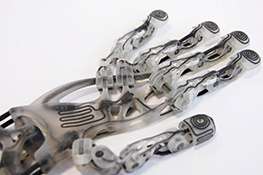The future of 3-D printing

Experts in 3D printing at the Engineering and Physical Sciences Research Council (EPSRC) Centre for Innovative Manufacturing in Additive Manufacturing at the University of Nottingham, have helped create a major new exhibition at London's Science Museum. One of the highlights of the 3D: Printing the Future exhibition is a 3D prosthetic arm, which shows how the technology could be used to print customised prosthetics with electronic moving parts and nerve endings, created by the research group at the University of Nottingham.
Among the 600-plus objects on display are a bladder, light aircraft part and 3D-printed pharmaceutical tablets, a collaboration between the EPSRC Centre for Innovative Manufacturing in Additive Manufacturing, and the University's School of Pharmacy. Some of the printed tablets are bilayered, allowing two different drugs to be released at varying speeds according to individual patient need. There are also toys modelled on real people including a mini version of Evan Davis from BBC Radio Four. A key point is that products can be customised.
The technology is transforming design and manufacturing processes and the Museum, has produced eight myth-busting videos, to talk about the possibilities. Will the technology be used to make guns? Will everyone have a 3D printer?
Additive manufacturing or 3D printing uses digital data to print thin layers of material such as polymer or metal and then fuses them with lasers to make solid objects. The Additive Manufacturing and 3D Printing Research Group (3DPRG) at the University of Nottingham is recognised as the world's leading research centre in the field and is a sponsor and adviser to the exhibition, 3D: Printing the Future.
Professor Richard Hague, Professor of Innovative Manufacturing at the University of Nottingham said additive manufacturing would help transform the industrial landscape, with more emphasis on smaller, localised manufacturing.
"At the moment, 3D printing uses single materials, a polymer or a metal, which are fused together with a laser. You can create interwoven geometries but they're still passive. What we're looking to do, is activate those and make them functionalise. So rather than make a component, you make the whole system—an example might be rather than print a case for a mobile phone, you make the whole phone—all the electronics, the case, the structural aspects, all in one print."



















